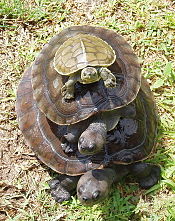Caspian turtle
| Caspian turtle | |
|---|---|
| Scientific classification | |
| Domain: | Eukaryota |
| Kingdom: | Animalia |
| Phylum: | Chordata |
| Class: | Reptilia |
| Order: | Testudines |
| Suborder: | Cryptodira |
| Superfamily: | Testudinoidea |
| Family: | Geoemydidae |
| Genus: | Mauremys |
| Species: | M. caspica
|
| Binomial name | |
| Mauremys caspica (Gmelin, 1774)
| |
| Synonyms[1] | |
| |
The Caspian turtle (Mauremys caspica), also known as the striped-neck terrapin, is a species of turtle in the family Geoemydidae (=Bataguridae). It is found in west Asia, in Iran and central Turkey, northward to the Republic of Georgia and eastward to southwestern Turkmenistan, and in Iraq, Saudi Arabia, and Bahrain.
Description
Mauremys caspica is a tan to blackish, medium-sized, semiaquatic turtle, which may attain a
Systematics
Three
The eastern Caspian turtle (Mauremys caspica caspica)
Siebenrock's Caspian turtle (M. c. siebenrocki )[5] occurs in Iran and Iraq, with relict populations in Saudi Arabia and on the island of Bahrain; it intergrades with M. c. caspica in Mesopotamia. This light form with contrasting colors resembles M. c. caspica, but has a yellow-to-orange plastron with a small to medium-sized, regularly shaped dark blotch on each scute. The soft parts are lighter than in M. c. caspica, and, unlike in other subspecies, age-related melanism does not occur in this subspecies.[4]
The spotted-bellied Caspian turtle (M. c. ventrimaculata)
The
According to Fritz and Wischuf,
The Spanish pond turtle (Mauremys leprosa) was formerly considered a subspecies of M. caspica, but studies of the
have shown it to be a separate species.Etymology
The subspecific name, siebenrocki, is in honor of Austrian herpetologist Friedrich Siebenrock.[12]
Ecology
Mauremys caspica occurs in large numbers in almost any permanent
Breeding usually takes place in early spring, but may also occur in the fall.[14] The courtship behavior has not been described, but must be similar to that in captivity. Nesting occurs in June and July. A typical clutch is four to six, elongated 20-30 x 35–40 mm (1.0 x 1.5 in), brittle-shelled, white eggs. Hatchlings have round carapaces about 33 mm (1.3 in) in length, and are brighter colored than the adults. The Caspian turtle may occur in large populations in certain areas, especially in permanent water bodies. In temporary waters, it is forced to aestivate in the mud in summer, and the more northern populations hibernate during winter. It often basks, but disappears at the least disturbance. Many are killed each year by humans who obtain their eggs to use in treating ubiquitous eye ailments.[14] Storks and vultures also take a heavy toll of juveniles and adults, respectively. It is carnivorous as juveniles with a shift towards being omnivorous as adults; larger individuals were observed to be more herbivorous. It feeds on small
References
- ISSN 1864-5755.
- ^ Gmelin, 1774.
- ^ a b c Wischuf and Fritz, 1996.
- ^ a b c d e f Fritz and Wischuf, 1997.
- ^ Wischuf and Fritz, in Fritz and Wischuf, 1997.
- ^ Valenciennes, 1833.
- ^ Fritz, 1995c.
- ^ Taskavak et al., 1997.
- ^ Buskirk et al., 2001.
- ^ Merkle, 1975.
- ^ Busack and Ernst, 1980.
- ISBN 978-1-4214-0135-5. (Mauremys caspica siebenrocki, p. 243).
- ^ Reed.
- ^ a b Anderson, 1979.
Further reading
- Busack, Stephen D.; Ernst, Carl H. (1980). "Variation in Mediterranean Populations of Mauremys Gray, 1869". Ann. Carnegie Mus. 49: 251–264.
- Buskirk, James R.; Parham, James F.; Feldman, Chris R. (2005). "On the hybridisation between two distantly related Asian turtles (Testudines: Sacalia × Mauremys)". Salamandra 41: 21–26. PDF fulltext[permanent dead link]
- Fritz, U.; Wischuf, T. (1997). "Zur Systematik westasiatisch-südosteuropaischer Bachschildkröten (Gattung Mauremys) (Reptilia: Testudines: Bataguridae)" Zool. Abh. Mus. Tierk. Dresden 49 (13): 223–260.
- Gmelin SG (1774). Reise durch Russland zur Untersuchung der drey Natur-Reiche. Dritter Theil [Volume 3]. Reise durch das nordliche Persien, in den Jahren 1770. 1771. bis April 1772. Saint Petersburg, Russia: Kayserliche Akademie der Wissenschaften. 508 pp. + Plates I-LII. (Testudo caspica, new species, p. 59 + Plates X & XL). (in German).
- Bory de Saint-Vincent JB (1833). "Vertébrés à sang froid. Reptiles et poissons ". pp. 57-80. In: Geoffroy Saint-Hilaire É(editor) (1833). Expédition Scientifique de Morée. Tome III, Première Partie. Paris: F.G. Levrault. 400 pp. + plates. (Emys rivulata, new species, Plate IX, figure 2). (in French).
- Wischuf, Tilman; Fritz, Uwe (1996). "Eine neue Unterart der Bachschildkröte ( Mauremys caspica ventrimaculata subsp. nov.) aus dem Iranischen Hochland [= A new subspecies of the Caspian turtle (Mauremys caspica ventrimaculata subsp. nov.) from the Iranian Highlands]. Salamandra 32 (2): 113–122.

